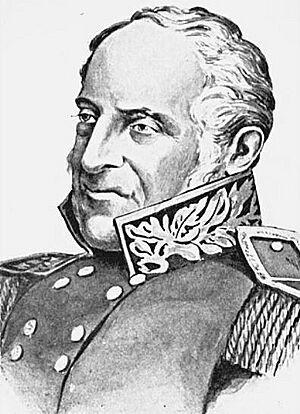Battle of Queenston Heights facts for kids
Quick facts for kids Battle of Queenston Heights |
|||||||
|---|---|---|---|---|---|---|---|
| Part of the War of 1812 | |||||||
 Death of General Brock at the Battle of Queenston Heights, John David Kelly |
|||||||
|
|||||||
| Belligerents | |||||||
| Commanders and leaders | |||||||
| Strength | |||||||
| 1,300 | 3,550 | ||||||
| Casualties and losses | |||||||
| 128 killed, wounded or captured | 1,105 killed, wounded or captured | ||||||
The Battle of Queenston Heights was a very important battle during the War of 1812. It happened on October 13, 1812, near Queenston, which was then called Upper Canada (now Ontario). The British won this battle.
It was a fight between American soldiers and New York citizen-soldiers, led by Major General Stephen Van Rensselaer. On the other side were British soldiers, Canadian citizen-soldiers (from York and Lincoln), and Mohawk warriors. They were led by Major General Isaac Brock and later by Major General Roger Hale Sheaffe, after Brock was killed.
The battle happened because the Americans tried to get a strong position on the Canadian side of the Niagara River. They wanted to do this before winter arrived and stopped the fighting. This big battle was the end of a poorly planned American attack. It is most famous for the death of the British commander, General Brock.
Even though the Americans had more soldiers, they couldn't get most of their army across the Niagara River. This was because of British cannons and because many American citizen-soldiers didn't want to cross. Because of this, British help arrived, defeated the American forces, and made them surrender.
Contents
Why the Battle Happened
The United States planned to attack Upper Canada in four different places. One attack was from Detroit, another across the Niagara River, a third across the St. Lawrence River towards Kingston, and the main attack from Lake Champlain to capture Montreal. The Americans hoped these attacks would quickly end the war.
However, these plans didn't work out. The American general in Detroit, William Hull, surrendered his army. The main American commander, General Henry Dearborn, stayed mostly inactive and didn't attack.
General Van Rensselaer, who was in charge of the Niagara attack, also had problems. He didn't have enough soldiers or supplies at first. Even though he was a Major General, he had never led troops in a battle before. He was a politician, not a soldier. He hoped his cousin, Colonel Solomon Van Rensselaer, who was an experienced soldier, would help him.
Getting Ready for Battle
British Preparations
Major General Isaac Brock was the leader of both the government and the military in Upper Canada. He was a very bold commander. He had successfully captured Detroit, which made him famous as the "saviour of Upper Canada." He even earned a special honor (knighthood) for it.
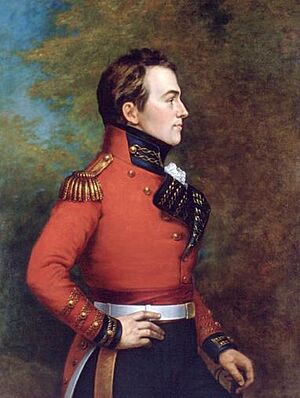
Brock wanted to cross the Niagara River and defeat the Americans quickly. But his boss, Lieutenant General Sir George Prevost, was more careful. Prevost thought peace talks might happen and didn't want Brock to start more fighting. He even arranged a temporary ceasefire.
However, the American government rejected the ceasefire and ordered their generals to keep fighting. This news took time to reach the front lines. While Brock was away, Major General Sheaffe had agreed to a ceasefire with the Americans. This allowed American soldiers and supplies to move freely, making Van Rensselaer's army much stronger. The ceasefire ended on September 8.
American Problems
Even with some American failures, Van Rensselaer's army grew much larger. He had about 6,000 soldiers. He also had another general, Brigadier General Alexander Smyth, with 1,700 regular soldiers. But Smyth refused to follow Van Rensselaer's orders. Smyth kept his troops near Buffalo, New York, instead of joining Van Rensselaer.
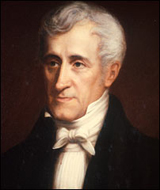
Van Rensselaer planned for his main force to cross the Niagara River from Lewiston and capture the high ground near Queenston. Smyth was supposed to attack Fort George from another direction. But Smyth ignored Van Rensselaer's messages and orders. Van Rensselaer decided to attack from Lewiston only, rather than delay the battle by dealing with Smyth. He wanted to create a strong base at Queenston for the winter.
On October 9, American sailors captured two British ships near Fort Erie. Brock heard about this and rushed to Fort Erie. He soon realized there was no immediate danger there and returned to his headquarters. However, the Americans mistakenly thought Brock had left for Detroit. Van Rensselaer decided to attack early on October 11.
But bad weather and a boatman who deserted with most of the oars caused the attack to be delayed. Colonel Van Rensselaer set the new attack date for October 13. Smyth, hearing about the delay, returned to his camp instead of moving to Lewiston. He told Van Rensselaer his troops would be ready on October 14, a day after the planned attack.
British Awareness
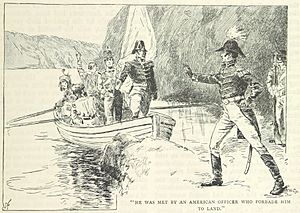
Brock knew about the failed American attempt to cross on October 11. On October 12, a British officer, Major Thomas Evans, crossed the river to arrange a prisoner exchange. He noticed several boats hidden along the American shore. He realized an attack was planned for October 13. Brock believed him and ordered some citizen-soldiers to gather that evening.
On October 13, Brock was at his headquarters. Major General Sheaffe was at Fort George with the main British army. Other British groups were at Queenston, Chippawa, and Fort Erie.
The Battle Begins
British Positions
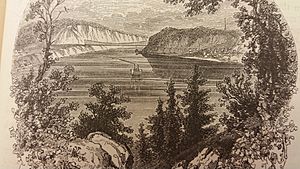
The village of Queenston was at the mouth of the Niagara River gorge. Just south of the village, the land rose 300 feet to Queenston Heights. The slope was very steep but had many shrubs and trees, making it climbable. Lewiston was on the American side. The river was fast and about 200 yards wide.
The British had a small group of soldiers at Queenston. This included soldiers from the 49th Regiment, citizen-soldiers from York, and a small cannon. Another group of 49th soldiers was in huts on top of the heights. Cannons were placed halfway up the Heights and at Vrooman's Point, a mile north of the village. More citizen-soldiers were stationed further north.
First American Attack
"The grape and musket balls, poured upon them at close quarters as they approached the shore, made incredible havoc. A single discharge from a field-piece directed by Captain Dennis himself (the captain of the 49th Grenadiers) killed fifteen in one boat."
The American army had about 900 regular soldiers and 2,650 citizen-soldiers. Most of the regular soldiers were new recruits. The Americans had twelve boats, each holding thirty men, and two larger boats for eighty men or cannons. Colonel Van Rensselaer led the citizen-soldiers, and Lieutenant Colonel John Chrystie led the regular soldiers.
The Americans started crossing the river in thirteen boats at 4 a.m. on October 13. Three boats were swept downstream by the current. Ten boats landed at Queenston village. A British guard saw them and quickly alerted his commander. British soldiers began firing at the Americans as they landed. Colonel Van Rensselaer was shot multiple times as he stepped out of his boat. Captain John E. Wool took command and tried to hold the American position.
British cannons began firing at the American landing area in Lewiston. American cannons fired back at Queenston village. The British soldiers were pushed back into the village but kept fighting from inside the houses.
As it got lighter, the British cannons became more accurate. As a second wave of American boats crossed, the crews of three boats panicked under fire and turned back. One boat was sunk by a British cannon. Three other boats, carrying Lieutenant Colonel John Fenwick and 80 men, drifted downstream. They landed in Hamilton Cove, where Canadian citizen-soldiers quickly surrounded them. Fenwick was badly wounded, and most of his men were killed or wounded. The survivors quickly surrendered.
General Brock's Death
At Fort George, General Brock heard the cannons at Queenston. He ordered some troops to move to Queenston and rode there himself with a few helpers. He reached the village at dawn and was cheered by his soldiers. He went to a cannon position to get a better view.
The British cannons were causing a lot of damage to the American boats. The American soldiers who had landed were stuck by the river. The wounded Colonel Solomon Van Rensselaer ordered Captains Wool and Ogilvie to climb the heights and attack the British cannon position. This position had very few guards. Wool's troops attacked just after Brock arrived, forcing Brock and his small group to retreat into the village. Brock sent a message to Major General Sheaffe to bring more troops to Queenston. He then decided to retake the cannon position right away.
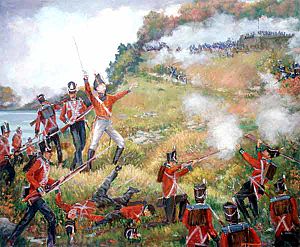
Brock led an attack with soldiers from the 49th Regiment and some citizen-soldiers. The attack was stopped by heavy American fire. Brock saw some of his men falling back and angrily told them that the 49th Regiment had never turned their backs before. This made the soldiers move forward again. Brock was joined by more citizen-soldiers. He ordered his aide, Lieutenant Colonel John Macdonell, to "Push on the York Volunteers" while he led his own group to the right.
Brock was shot in the wrist but kept leading the attack. His tall height, energetic movements, and bright uniform made him an easy target. He was shot in the chest by an unknown American soldier from about fifty yards away. The shot killed him almost instantly. His body was carried away and hidden in a nearby house.
Even though he was a lawyer, Lieutenant Colonel Macdonell led a second attempt to retake the cannon position. With about 70 to 80 men, more than half of whom were citizen-soldiers, they advanced. The Americans had been reinforced and had about four hundred soldiers.
Despite being outnumbered, Macdonell's small force pushed the Americans back. But then Macdonell's horse was shot, and he was hit in the back, falling from his horse. He was taken from the battlefield but died the next day. Captain Williams was wounded in the head, and Dennis was badly wounded in the thigh. Carrying Macdonell and Brock's body, the British fell back through Queenston.
Legend says Brock's last words were "Push on, brave York Volunteers," but this is unlikely because he wasn't with them when he fell. Also, his wound suggests he died too quickly to speak.
Mid-Battle Movements
By 10 a.m., the Americans were only being fired upon by one British cannon far away. The Americans were able to bring several hundred fresh troops and a cannon across the river. They also got the 18-pounder cannon working again at the captured position. Some American soldiers went into Queenston village and took things from houses.

Colonel Chrystie briefly took charge of the American troops in Canada but returned to Lewiston for more soldiers and tools. Around noon, General Van Rensselaer and Chrystie crossed to the Canadian side. They ordered the Queenston Heights position to be made stronger. Van Rensselaer put Lieutenant Colonel Winfield Scott in command of the regular soldiers on the Heights. Brigadier General William Wadsworth took charge of the citizen-soldiers. Only about a thousand American soldiers had crossed the river.
Meanwhile, British help started arriving from Fort George. Cannons and soldiers from the 41st Regiment moved into Queenston village. When they started firing at 1 p.m., it became dangerous for American boats to cross the river again. Two American boats were sunk.
At the same time, 300 Mohawk warriors climbed the heights and attacked Scott's outposts. The Mohawks were pushed back, but the Americans were scared by the native warriors. War cries could be heard in Lewiston, and American citizen-soldiers waiting there refused to cross the river.
Sheaffe's Attack
Sheaffe arrived at Queenston at 2 p.m. and took command of the British troops. He ordered more help to join him. When they arrived, he led his force on a three-mile detour to the Heights, keeping them safe from American cannons. He was joined by more soldiers from Chippawa. In total, he had over 800 men, including soldiers from the 41st Regiment and several companies of citizen-soldiers (including a company of Black Canadians).
General Van Rensselaer decided to go back to Lewiston to get more soldiers and supplies. But his boat was crowded with people trying to escape and almost sank. In Lewiston, he found that his troops were a messy crowd. He couldn't convince any more citizen-soldiers to cross the river. He tried to get civilian boatmen to bring his soldiers back from Canada, but they refused. He sent a message to General Wadsworth, letting him decide whether to fight or retreat.
As Sheaffe's army began to move forward, Scott and Wadsworth received Van Rensselaer's message. Scott said that the American force on the heights was now only about 125 regular infantry, 14 artillerymen, and 296 citizen-soldiers. The Americans decided to leave their unfinished defenses and retreat. Scott tried to build a barricade of fences and brushwood to cover their escape.
Sheaffe took his time getting his men ready and attacked at 4 p.m., twelve hours after Van Rensselaer started his assault. The first attack was made by soldiers from the 41st Regiment with citizen-soldiers and some Native Americans. They charged with bayonets, making the American riflemen retreat. Sheaffe then ordered a general advance. The entire British line fired their guns, let out war-whoops, and charged. The American citizen-soldiers, hearing the Mohawk war cries and thinking they were going to be killed, ran away without orders. General Wadsworth surrendered with 300 men. Scott and others tried to get down to the river. With no boats to pick them up and the Mohawk warriors angry, Scott feared a massacre and surrendered to the British.
After the surrender, Scott was surprised to see 500 more citizen-soldiers, who had been hiding, come out to surrender as well.
Battle Losses
The British officially reported 14 killed, 77 wounded, and 21 missing. This did not include the Mohawk warriors. Historians now believe the British and Canadian losses were 16 killed, 83 wounded, and 21 captured. The Native American losses were 5 killed, 2 wounded, and 1 captured. This makes a total of 21 killed, 85 wounded, and 22 captured. Among the wounded Canadians was James Secord, the husband of Laura Secord.
The number of Americans killed is estimated to be between 60 and 100. 82 badly wounded Americans were taken across the Niagara River before the surrender. 955 Americans were captured by the British, including 120 badly wounded officers and men. Many of the wounded had to be cared for in churches because the hospital was full. In total, American casualties were 60–100 killed, 80 wounded, 90 wounded prisoners, and 835 other prisoners. Six American officers were killed, and many more were wounded or captured. A cannon and a flag from a New York citizen-soldier regiment were also captured.
What Happened Next
Sheaffe immediately offered a temporary ceasefire and invited Van Rensselaer to send doctors to help the wounded. General Van Rensselaer resigned right after the battle. He was replaced by Alexander Smyth, the officer who had refused to help the invasion. Smyth still had his regular soldiers but refused to attack until he had 3,000 men. He launched a small successful raid but then failed two attempts to cross the river. Smyth became very unpopular and secretly left his post.
In Albany, the defeat of Van Rensselaer made General Henry Dearborn even more unwilling to act. With two armies already defeated, Dearborn didn't want to lead a third. He led a weak advance but his citizen-soldiers refused to go further. After his regular soldiers were easily pushed back, Dearborn returned to American territory. He was replaced the next year.
The question of who was to blame for the defeat was never fully answered. Stephen Van Rensselaer remained popular enough to try to become Governor of New York and later served in the U.S. House of Representatives. The Secretary of War, General John Armstrong, Jr., blamed General Van Rensselaer after the war. This made Solomon Van Rensselaer angry, and he blamed Lieutenant Colonel Chrystie for the disaster.
The loss of General Brock was a big blow to the British. Brock had inspired his soldiers and the people of Upper Canada with his confidence. Sheaffe, who took over, received a special honor for the victory but wasn't as respected. He was known as a strict leader. Even though he won, he was criticized for not attacking Fort Niagara after the battle. The next year, he was defeated at the Battle of York. He was later removed from his positions in Upper Canada.
Legacy of the Battle
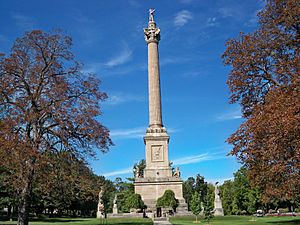
A tall column, 56 meters (185 feet) high, called Brock's Monument, stands on Queenston Heights in Ontario, Canada. It remembers the battle and General Isaac Brock who died there.
The song "MacDonell on the Heights" by Stan Rogers tells the story of John Macdonell's role in the battle.
Two British Regiments, the 41st and 49th, were given the special honor "Queenstown" for their bravery in the battle. Their modern-day army units still carry this honor.
In the Canadian Army, several regiments keep alive the history of the Canadian citizen-soldier units that fought in the battle. These regiments also have the Queenston Heights Battle Honour.
The Ontario Highway 405 that connects to the Queenston-Lewiston Bridge is named the General Brock Parkway.
Many songs have been written about the battle. In 1959, a Toronto radio station recorded "The Battle of Queenston Heights," which became a local hit song.
Many streets, avenues, roads, and a university in Ontario are named after Major-General Brock. The city of Brockville is also named after him.
See also
 In Spanish: Batalla de Queenston Heights para niños
In Spanish: Batalla de Queenston Heights para niños



